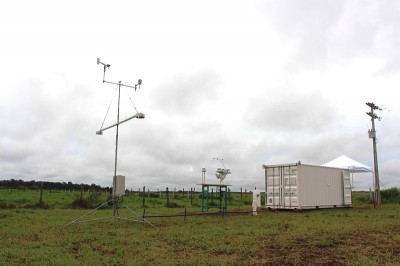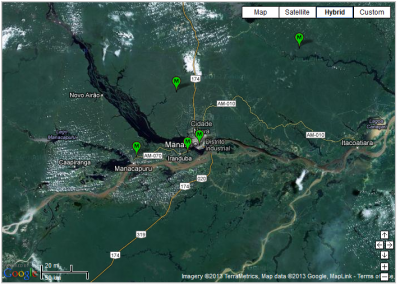Gearing Up for Science in Amazon Rainforest
Published: 30 April 2013

Preparing for the biggest and most complex deployment of field resources to date, the ARM Mobile Facility operations team from Los Alamos National Laboratory spent three weeks in Brazil in early March tackling a range of protocol and logistics tasks for next year’s GOAMAZON field campaign. Between ARM and Brazilian collaborators, about 80 instruments will obtain measurements from various locations around Manaus in the Amazon Basin, also known as Amazonia, for two years beginning in January 2014.
Foreshadowing this deployment in the world’s largest rainforest, the team persevered through heavy rains followed by scorching sun and 100% humidity. Led by Heath Powers, they installed an initial instrument suite at the primary observation site, located on private grazing lands about 70 kilometers west of Manaus, near the city of Manacapuru (pop. 90,000).
Though surrounded by jungle, the farm site—referred to as T3—is wide open with an ideal field of view for all instruments. Instruments now operating at the site include: six radiometers, a ceilometer, and a surface meteorological system. Instruments will be checked once a week, with data stored onsite and backups on thumb drives.
In 2014, the ARM Mobile Facility and Mobile Aerosol Observing System will also operate from this site, so the team also spent time planning and preparing for their arrival in fall of 2013. For instance, the small power pole currently in place will be replaced with a much larger transformer to handle the load requirements of the full instrument suite. The team also discussed the challenges presented by the area’s high humidity and resulting condensation, as well as the prevalence of lightning.
Bruno Takeshi Tanaka, project manager from National Institute for Research in the Amazon (INPA) and head of Brazilian logistics and communications for GOAMAZON, provided guidance to the team based on his extensive science background and instrumentation experience.

Project links atmosphere with biosphere
Manaus is an isolated metropolis of two million people, surrounded by natural forest for thousands of kilometers in every direction within the Amazon Basin. To obtain comprehensive measurements of the movement and minute properties of the heavily polluted plume from Manaus out over the rainforest, the international science team identified several strategic locations to place different instruments.
In addition to the T3 farm site, two remote sites—T0 and T1—on the outskirts of Manaus are equipped with automated weather stations to gather data about basic meteorological conditions in the urban area. Another site, T2, is located near Iranduba, between Manaus and Manacapuru. When the ARM Mobile Facility arrives at the farm site, the instruments installed in March will be relocated to T2, along with the mobile facility’s Aerosol Observing System and guest instruments contributed by Brazilian collaborators. Finally, a fifth site, called ZF2 and located north of Manaus, will host surface flux instrumentation provided by DOE’s Terrestrial Ecosystem Science program.
Numerous other observational efforts coinciding with GOAMAZON are sponsored by the U.S. DOE, Brazilian, and German collaborators. These combined observations, including airborne sampling, will provide a benchmark data set vital to constrain tropical forest models for organic aerosol, cloud, and convection schemes, as well as vegetation components. The data set will provide insights into how these components are perturbed by pollution and how they influence climate.
The ARM Climate Research Facility is a DOE Office of Science user facility. The ARM Facility is operated by nine DOE national laboratories, including .
Keep up with the Atmospheric Observer
Updates on ARM news, events, and opportunities delivered to your inbox
ARM User Profile
ARM welcomes users from all institutions and nations. A free ARM user account is needed to access ARM data.


















